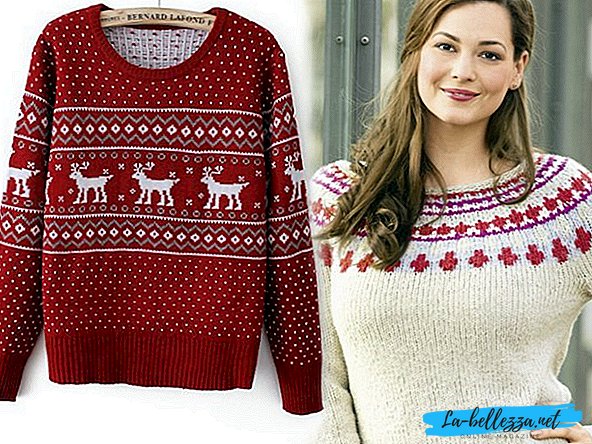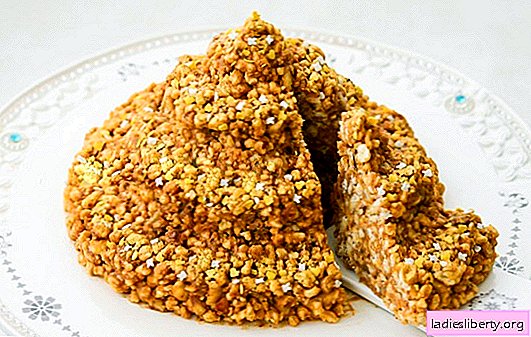
Jacquard patterns are a very popular style of knitting with warm clothing that the older generation remembers with nostalgia, and young people with pleasure prove that it is ageless classics for all cold times.
Feature of jacquard pattern - repetition of the same pattern made in a contrasting color scheme throughout the entire knitting. In addition, the pattern in this style can be only one for the whole product, as often happens in the children's version of knitting.
In jacquard knitting, there are no "tricky" eyelets and super-complex plexuses, although some ornaments are really difficult to perform, especially for beginning needlewomen. Skilled knitting needles love jacquard patterns for the ability to combine a variety of motifs, and often make up their own, unique patterns.
Classic ornament is known to all: deer, Christmas trees, snowflakes, diamonds and braids. Professionals call it the Norwegian patterns and ornament meander. Therefore, jacquard patterns are often chosen for warm sweaters, socks, hats, mittens, pullovers, scarves. "Funny" motifs with animals and plants look equally cool on adults, and on teenagers, and on children. And how they cheer up and complement the festive atmosphere in the pre-New Year bustle!
Patterns knitting jacquard patterns knitting patterns and descriptions
Jacquard patterns are knitted according to the counting patterns, in which one cell is one loop, and each sign is a specific color of the thread. Patterns knit according to the scheme from the bottom up.
What are the features of knitting jacquard patterns knitting? They are knitted with the front satin stitch, and the threads of the desired color should be used both in the front and in the purl loops. Thus, on the front side, the pattern we need will appear, and on the wrong side characteristic broaches and weaves will appear. The edge hinges in the multi-colored rows are knitted in two colors simultaneously.
There is a way that describes how to knit jacquard pattern without broaches. Consider it on the example of a simple jacquard pattern.
Classic snowflake knitting without broaches

For work you will need:
We take 2 threads contrasting in color with each other.
The threads along the entire length must be made of the same high quality yarn. It is important to make sure in advance that the colors of the threads do not shed.
Working process:
We collect 23 loops with needles and two more edging, in the end it will be 25. The first row of the scheme is knitted with the wrong side, only with blue yarn. The finishing edge loop is knitted synchronously with two colors of threads. Further, when work with subsequent rows will occur, it is imperative to knit the edge loops in the manner described above.
This method will preserve the tension of the threads along the edges of the product and will not give the opportunity to form vertical broaches. Starting to knit the front row with needles, it is necessary to remove the edge loop. Now two threads will be simultaneously involved, which should alternate.

In the diagram, you can see that the first loop is knitted in yellow. That knitting turned out without broaches, this thread is seized from the other sideimitating tying blue yarn, although it is closer. We knit this loop and tighten two threads so that the product has a good density.

Then we begin to knit in blue. This thread is located a little further from the knitting needles than the yellow yarn. To create this loop, you need to hold the needle to the right under the yellow, capturing the blue and knitting it. After each formation of the loop, the thread should be tightened.
The following actions will be simple, based on the drawing of the scheme and avoiding broaches, follow the same rules as described above. Be sure to knit the edge loops with two threads at once. Observing such not tricky rules, you will be able to associate a beautiful and dense product with a beautiful pattern. In the presented photos, you can see the wrong and the front side of the mating.
Simple patterns for beginners.
Jacquard patterns are considered fairly simple among other ways of knitting, but even among them there is a separate special category for beginners - simple. To make it easier for beginning knitters, we collected simple jacquard patterns with knitting needles, diagrams and descriptions to which are more than available.
Jacquard Zigzag

This two-color zigzag knits according to the following simple description:
16 loops rapport + 2 edging.
The height of the pattern is from row 3 to row 14.

Two-tone jacquard pattern of oblique loops

Pattern Description:
Rapport 3 loops + 1 loop for balance + 2 edge
- 1st row: (thread A) face loops.
- 2nd row: (thread B) * 2 purl, 1 loop to remove - thread before work, * 1 purl.
- 3rd row: (thread B) 1 front, * transfer 1 loop to the auxiliary needle before work, 2 front ones, knit the front loop with the auxiliary needle *
- 4th row: (thread A) 1 purl, * 1 loop to remove - thread before work, 2 purl, *
- 5th row: (thread A) * translate 2 loops to the auxiliary knitting needle at work, 1 face, knit the face loops with the auxiliary needle * 1 face.
- 6th row: repeat from the second row.
Drawing for children
Jacquard knitting patterns for children are also rich in a variety of patterns. It can be as simple cartoon pictures, embroidered on sweaters, hats, mittens, socks, and thematic patterns for all occasions.
Christmas tree Christmas

Report a pattern of 12 loops. It is necessary to repeat the pattern according to the scheme from the 1st to the 20th rows. In the purl rows of the loop, knit on the pattern of the fabric, nakida purl. Two loops together facial knit with a slope to the right. The pattern looks good in dark and light colors.
Knitting needles according to the scheme:

Jacquard fox pattern

To link one or several patterns of fox on 32 loops, you need:
Knit the front satin on the counting scheme of individual cubes. The diagram below shows only the front rows. In purl rows knit according to the pattern. When changing colors, constantly cross the threads on the wrong side. This is necessary in order not to form holes.
Act according to the scheme:

Lazy jacquard patterns
Another type of simple jacquard patterns is lazy. Often this is the simplest repeating ornament. Many lazy patterns knit on the principle: every two rows of the same color, after which the tangle changes. The pattern itself is born after stretching the loops from other rows. Here are some lazy jacquard patterns for knitting with patterns.
Lazy jacquard stripes

The diagram shows the front and back rows. Letters denote thread colors.
In high rapport repeat from 1 to 22 row. Rapport width 2 loops + 1 loop to rapport + 1 loop after rapport + 2 edging.

Explanations for knitting lazy jacquard pattern:
Each row is knitted with a thread of the main color, while the loop corresponding to the thread of a different color is not knitted, but is removed, the working thread remains behind the loops. In the knitted “lazy” patterns, each loop, each row is listed in a strict order. After knitting a specified number of rows, they return to the first and all operations are repeated.
In the diagrams, only the front rows are indicated, since the purses in all the patterns of this type are knitted according to one rule: the loops knitted in the previous odd row are knitted with the purses of the same color, and the loops removed in the previous row are again removed without tying, and the working thread should go on top of the loop.
Letters A and B opposite to the first rows of the scheme indicate the color of the thread, which two paired rows are knitted: the front and the back. For example, the 1st and 2nd rows are knitted with a thread of color A, while the loop denoting color B is removed, the thread on the front side remains at work, on the wrong side - before work. Further, the colors of the thread alternate every two pairs of rows.
Patterns begin with knitting a pattern, so two initial rows need to be tied with a thread of color B. If desired, not two but more colors of yarn can participate in the pattern, but the principle of alternating colors remains the same.
Lazy Jacquard Honeycomb

For knitting this pattern yarn of two colors is used. Every two rows fit in one color according to the following scheme with a description:

Patterns for sweaters
A jacquard sweater is a winter hit for all times, because such things never go out of style. Sweaters with snowflakes, deer, Christmas trees and all sorts of geometric shapes are already strongly associated with many New Year holidays, along with the “Irony of Fate”, champagne and the smell of mandarin. We offer several variants of schemes with descriptions of knitting sweaters with jacquard pattern.
Classic sweater with deer

Sweater sizes: 42, 44, 46, 48 and 50.
Suitable for sweaters: Sisu yarn (wool 80%, nylon 20%). Yarn consumption for each of the sizes: 350, 400, 400, 450 and 450 grams of light shade and 100 grams of dark. Circular needles number 2 and 3.5 are required.
Mating density is twenty-seven loops - ten centimeters.
Knit jacquard pattern according to the following detailed scheme:

The first is knitting forehand and back. At the initial stage, you need to dial a certain number of loops of light yarn for circular knitting needles under the second number, 220, 244, 264, 288 and 308, respectively. Next, a two-by-two elastic band will knit with two face and two seam elements (6 cm, for the remaining two - 7 cm.
After that, you have to change the needles to the third number and knit on the basis of persons. smooth Having tied up forty one centimeter, the loops are divided into two parts for the front and back (into 100, 112, 122, 134 and 144 links). Among these loops you need to close by ten for the armhole. Now you can leave them for a while.
To create sleeves sweaters with deer, action plan such: make a set of such a number of loops of light yarn (knitting needles No. 2): 52, 56, 60, 60 and 64. Then there is a two-by-two circular knitting of gum, 6 cm long for sizes 42, 44 and 46 and 7 cm - 48 and 50. The next stage is the transition to the spokes under the third number. In the first row, you need to add 5, 5, 9, 7 eyelets = 57, 61, 65, 69 and 71 loops. Next comes the facial surface.
In order to expand the sleeve, a uniform number of links is added, namely, 28 for all sizes except the last fiftieth, in this case their number will be 32 pieces. Then comes the addition of one loop in all tenth rows on both sides of the first. Through 47, 47, 48, 48 and 48 cm on the needles: 85, 89, 93, 97 and 103 buttonholes. Further, the first link of the fifth on each side of it (a total of eleven) is closed for the armhole. In the balance, respectively: 74, 78, 82, 86, 92 links (they are deposited).
A further step in knitting a sweater with deer will be the creation of a yoke using circular needles with the number three, where the pending links are placed (= 348, 380, 408, 440, 472). Tie cut "A" according to the scheme. Having reached the fifth row, it is worthwhile to carry out a uniform decrease of the elements: 28, 28, 24, 24 and 24 = 320, 352, 384, 416 and 448.
Now according to the scheme segment "B" is knitted. Note that the arrow indicates the desired size. Reduction of links occurs as indicated by the scheme (this is necessary to narrow the sweater). After you finish to a certain mark, put an additional knitting needle into the work. For this instrument, the middle twenty-two buttonholes are taken along the front and back. Those links that remain are tied as facial and purl rows until the end of segment "B" in the diagram.
After finishing knitting segment "B" on the tools you should have the following number of links: 172, 184, 196, 212 and 228, taking into account the loops with additional knitting needles. Next comes the knitting segment "C". At the end, proceed to a uniform decrease: 52, 56, 60, 64 and 68. Now you can go to the spokes under the second number.
The latest in knitting a sweater with deer is knitting the gate on the basis of a rubber band two by two: 16, 16, 17, 18 and 18 cm. The final stage consists in closing all eyelets and sewing the sleeves into the armholes.
Cute knitting sweater with a deer for a child

Dimensions: 2/4/6 / 8-10 / 12 years.
For knitting with a jacquard pattern, you need: 3/3/4/4/5 skeins of turquoise Piscine, 1/1/1/1/2 skeins of cream Sable Phil Frenesie yarn (37% cotton, 26% wool, 15% polyamide, 12% mohair, 130 m / 50 g ). 1/1/1/2/2 hank dark gray Touareg Partner 3.5 yarn (50% polyamide, 25% acrylic, 25% wool; 50 g / 125 m). Spokes number 3.5 and number 4.
Elastic: alternately 1 person., 1 out.
Facial surface: individuals. R. - persons. n., izn. R. - ex. P.
Jacquard pattern: knit faces. stitch by countable scheme. When changing the color, cross the threads on the wrong side so that no holes appear.
Knitting density
The front surface, thread Phil Frenesie, needles number 4: 19 n. And 28 p. = 10 x 10 cm
Jacquard pattern, needles number 4: 41 n. And 30 p. = 20 x 10 cm
Description of knitting pullover according to the following schemes:


Back: on the needles number 3.5 thread Piscine dial 60/66/72/78/88 p. and tie 2 cm (= 6 p.) elastic. Go to the needles number 4 and knit persons. stitch, adding 1 p. = 61/67/73/79/89 p. Through 20.5 / 22.5 / 24.5 / 28 / 31.5 cm (= 58/64/68/78/88 pp. ) from the gum for armholes close 1 x 2 p. on both sides, then in each 2nd p. 1 x 2 p. And 2 x 1 p. = 49/55/61/67/77 p.
Through 32.5 / 36.5 / 40.5 / 45.5 / 51.5 cm (= 92/102/114/128/144 p.) From the rubber for the bevels of the shoulders, close on both sides 1 x 3 p. / 1 x 3 n. / 1 x 4 n. / 1 x 4 n. / 1 x 5 n. And in each 2nd p. 3 x 3 n. / 1 x 3 n., 2 x 4 n. / 3 x 4 n. / 1 x 4 n., 2 x 5 n. / 1 x 5 n., 2 x 6 n. At the same time for the notch close the mouths of the middle 9/9/9/11/11 p. and knit further separately, closing along the edges of the notch in each 2nd p. 2 x 4 nos. / 1 x 5 nos., 1 x 4 nos. / 2 x 5 nos. / 2 x 5 nos. / 1 x 6 nos., 1 x 5 nos.
Before: on the needles number 3.5 thread Piscine dial 60/66/72/78/88 p. and tie 2 cm (= 6 p.) elastic. Go to the needles number 4 and knit jacquard pattern according to the appropriate scheme, adding evenly in the 1st p. 5/5/5/7 / E p. = 65/71/77/85/97 p. Through 20.5 / 22.5 / 24.5 / 28 / 31.5 cm (= 62/68/74 / 84/94 p.) From the gum for armholes to close on both sides 1 x 2 n., Then in each 2nd p. 1 x 2 p. 2 x 1 p. = 53/59/65/73/85 p.
Through 29.5 / 33.5 / 36.5 / 41.5 / 46.5 cm (= 88/100/110/124/140 p.) From the elastic for the neckline close the average 9/9/9/11 / 11 n. And knit further separately, closing along the edges of the notch in each 2nd p. 1 x 3 nos., 2 x 2 nos., 2 x 1 nos. / 2 x 3 nos., 1 x 2 nos., 2 x 1 nos. / 1 x 4 nos., 1 x 3 nos., 1 x 2 p., 2 x 1 p. / 1 x 4 p., 1 x 3 p., 1 x 2 p., 2 x 1 p. / 1 x 4 p., 1 x 3 p., 2 x 2 p. ., 1 x 1 p.
Sleeves:on the needles number 3.5 thread Piscine dial 36/38/40/44/46 p. and tie 2.5 cm (= 8 p.) elastic. Go to the needles number 4 and knit persons. stitch, adding 1 p. = 37/39/41/45/47 p. Add on both sides in each 12-m p. 2 x 1 p., In each 10th p. 2 x 1 p./ through 10 p. 1 x 1 p., In every 8th p. 6 x 1 n. / In every 8th p. 6 x 1 p., In every 6th p. 4 x 1 p. / In every 8th p. 11 x 1 p. / In every 8th p. 7 x 1 p., In every 6th p. 8 x 1 p. = 45/53/61/67/77 p.
Through 19 / 23.5 / 28/34 / 39.5 cm (= 54/66/78/94/110 r.) From the gum for the dummy of the sleeve, close on both sides 1 x 3 n. / 1 x 4 n. / 1 x 4 p. / 1 x 4 p. / 1 x 5 p., Then in each 2nd p. 2 x 2 nos., 2 x 1 nos., 2 x 2 nos., 1 x 3 nos. / 1 x 3 nos., 1 x 2 nos., 2 x 1 nos., 1 x 2 nos., 1 x 3 p., 1 x 4 p. / 2 x 3 p., 2 x 2 p., 2 x 3 p., 1 x 4 p. / 1 x 4 p., 2 x 3 p., 1 x 2 p ., 1 x 3 p., 2 x 4 p. / 2 x 4 p., 2 x 3 p., 2 x 4 p., 1 x 5 p. Through 25 / 29.5 / 34/40/45, 5 cm (= 70/82/94/110/126 p.) From the gum to close the remaining 13 p.
Neckline: on the needles number 3.5 thread Piscine dial 70/74/80/84/90 p., tie 2 cm (= 6 p.) rubber band, 1 person. R. individuals. n. and several rows of persons. stitch contrasting thread. Iron these rows and dissolve them when assembling up to the main thread.
Assembly: perform shoulder seams, side seams and seams of the sleeves. Sew on the sleeves. Sew the bar to the cut with a kettle stitch from the faces. parties.
Video lesson
To help beginners to knit jacquard pattern with knitting needles, you can use the help of professional knitters who show in detail each needles manipulation with threads. Such a Norwegian motive would look great on women's, men's and children's clothes. It is especially convenient that this jacquard pattern is knitted in a circle, and it turns out without broaches.
Video: how to tie a beautiful jacquard knitting pattern











